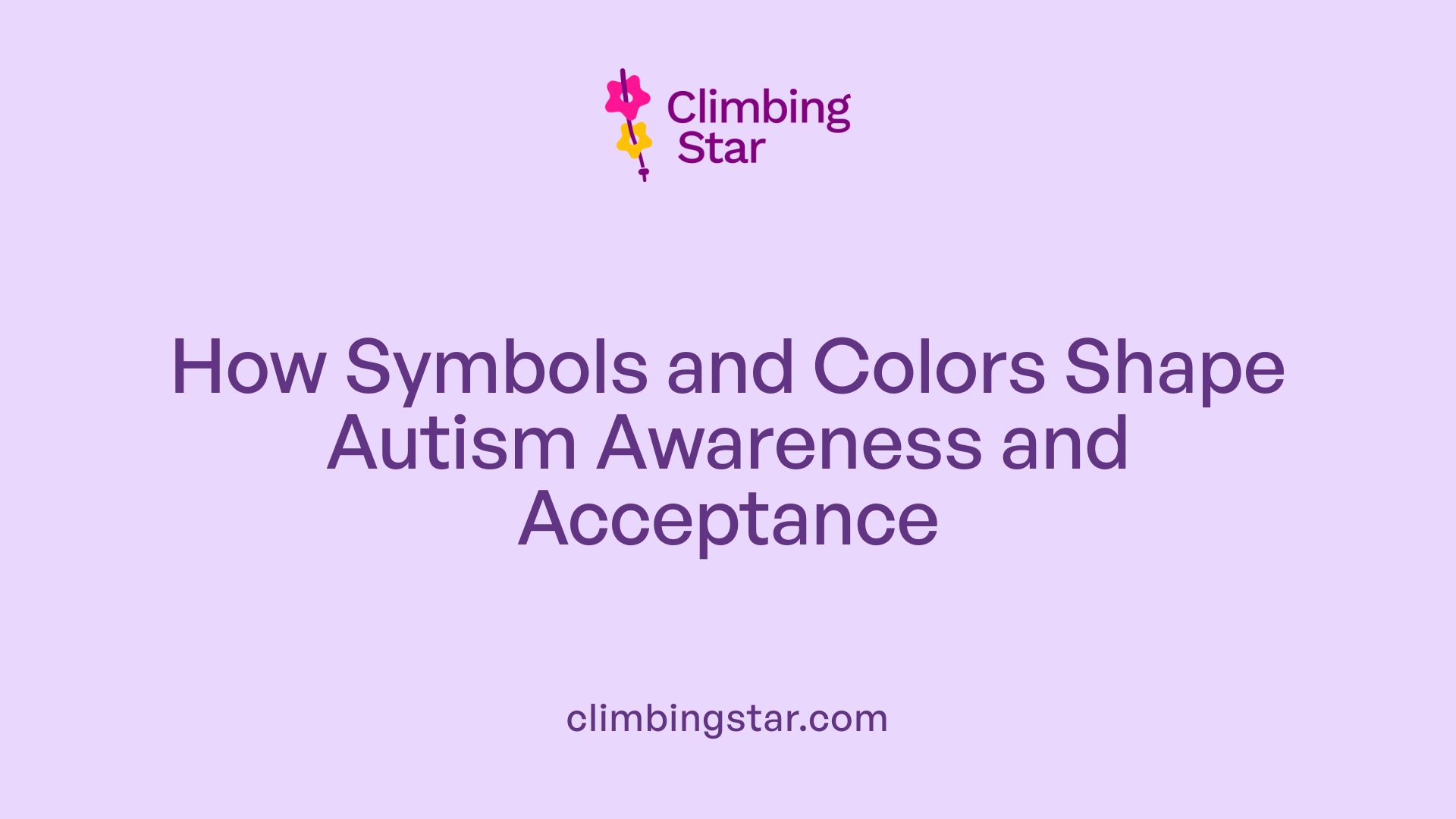Understanding the Visual Language of Autism
Autism awareness has been shaped and enhanced by a variety of symbols and colors, each carrying unique meanings that reflect the diversity and complexity of the autism spectrum. These symbols and hues play a crucial role not only in raising public awareness but also in fostering acceptance, understanding, and advocacy for individuals on the spectrum. This article delves into the key autism symbols, the significance of various colors, and the role that behavioral therapies like Applied Behavior Analysis (ABA) play in supporting individuals with autism.
The Puzzle Piece: A Traditional yet Controversial Symbol

What is the significance of the puzzle piece in autism awareness?
The puzzle piece is one of the most widely recognized symbols representing autism. Introduced by the National Autistic Society in 1963, it conveys the complexity and diverse nature of the autism spectrum. Each piece reflects the many different traits, strengths, and challenges experienced by autistic individuals, emphasizing that autism is multifaceted rather than singular.
Are there critiques related to the puzzle piece symbol?
Despite its widespread use, the puzzle piece has faced criticism, particularly from autistic individuals and advocates. Some argue that it suggests autism is something incomplete or broken—like a puzzle missing pieces—which can inadvertently contribute to stigma. This perception has led to movements toward adopting alternative symbols that focus more on acceptance, diversity, and empowerment within the autism community.
The history of the puzzle piece symbol showcases both its longstanding role in autism awareness and the evolving discourse around respectful representation. While it remains commonly used, ongoing conversations encourage a more inclusive approach to how autism is visually represented and understood.
The Infinity Symbol and Neurodiversity Movement

What does the infinity symbol represent in autism awareness?
The infinity symbol in autism awareness is a powerful emblem that reflects ongoing support and understanding for autistic individuals. It represents the diversity and endless possibilities within the autism spectrum, emphasizing that the potential of autistic people is limitless.
Connection with neurodiversity
This symbol is closely tied to the neurodiversity movement, which advocates for recognizing and respecting neurological differences as natural variations rather than disorders. The infinity loop highlights the continuous and boundless nature of support and acceptance that the community seeks.
Use of rainbow colors in the infinity symbol
Often, the infinity symbol is depicted in rainbow colors. This use of the rainbow spectrum enhances its meaning by symbolizing inclusion and the full range of experiences, strengths, and challenges faced by autistic individuals. The rainbow hues underscore the community's diversity and drive toward a more accepting and understanding society.
Colors of Autism Awareness: Blue, Gold, Red, Yellow, and Rainbow
What is the significance of blue in autism awareness?
Blue is strongly associated with autism awareness, particularly through campaigns like "Light It Up Blue." This color symbolizes calmness, trust, and a collective effort to promote understanding and acceptance of autistic individuals. However, it has faced some criticism for focusing more on awareness rather than full acceptance within parts of the autism community.
How is gold used to represent acceptance and diversity?
Gold is used as a powerful symbol of acceptance, diversity, and the unique strengths that autistic individuals bring to society. Emphasizing neurodiversity, gold highlights the idea that autism is not a deficit but a variation with valuable perspectives and talents.
What roles do red and yellow play in advocacy and positivity?
Colors like red and yellow convey passion, hope, love, and joy within the autism community. Red represents advocacy and passionate support, while yellow brings a message of positivity and bright optimism. Together, they illustrate the emotional diversity and resilience of those on the spectrum.
How does the rainbow spectrum symbolize the autism community?
The rainbow spectrum serves as a collective emblem of the broad range of emotions, strengths, and challenges experienced by individuals with autism. Its multicolored ribbon form embraces inclusion and recognition of diverse experiences on the spectrum, reinforcing a message of unity and acceptance across the community.
The Multi-Colored Puzzle Piece Ribbon and Autism Awareness Ribbon

What Does the Multi-Colored Puzzle Piece Ribbon Symbolize?
The multi-colored puzzle piece ribbon is a widely recognized emblem that represents the complex and diverse nature of the autism spectrum. Each color in the ribbon highlights the varied experiences and unique traits found among individuals on the spectrum, echoing the intricate puzzle that autism represents. This diversity is essential in understanding that autism is not a one-dimensional condition but a broad spectrum with many facets.
Why Is This Ribbon Useful in Representing Autism Diversity?
This symbol effectively captures the richness of the autism community by showcasing multiple colors — a visual cue that signifies the range of emotions, strengths, and challenges people with autism face. The puzzle piece, as a whole, underscores the important idea that every individual’s experience with autism fits together with others to form a larger, complex picture.
The Autism Awareness Ribbon and Its Evolution
Alongside the puzzle piece ribbon, the autism awareness ribbon often features multiple colors and reflects evolving perspectives on autism advocacy. Initially centered on awareness, these ribbons now move beyond to emphasize acceptance and support. Over time, the symbolism has expanded from simply recognizing autism to promoting inclusivity, understanding, and appreciation of neurodiversity.
How Do These Symbols Focus on Acceptance and Understanding?
By incorporating bright colors and a range of hues, the ribbons advocate for not just awareness but active acceptance and understanding of autistic individuals. This shift in focus supports fostering a society that values neurodiversity and respects the unique contributions of people with autism, encouraging empathetic conversations and inclusive policies.
Butterfly Symbolism: Growth, Development, and Transformation
What Does the Butterfly Symbol Mean in Autism?
The butterfly is a powerful and meaningful symbol within the autism community, representing growth, development, and transformation. Just as a butterfly undergoes a complete metamorphosis—from a caterpillar to a beautiful winged creature—this imagery captures the potential for positive change and ongoing personal evolution experienced by many autistic individuals throughout their lives.
How Does the Butterfly Represent Positive Change and Development?
This symbol speaks to the journey of transformation, emphasizing that autism is not a limitation but a developmental process where new skills, understanding, and adaptations continuously emerge. It reflects hope and resilience, highlighting that individuals on the spectrum can thrive and flourish with the right support and environment.
The butterfly serves as an optimistic reminder of progress and the dynamic nature of autism, encouraging acceptance and celebration of each person's unique journey and achievements.
Applied Behavior Analysis: A Therapy Grounded in Behavioral Science
What is ABA therapy?
Applied Behavior Analysis (ABA) is a scientifically grounded therapy aimed at helping individuals with autism enhance their social interaction, communication, and learning capabilities. It focuses on understanding behavior by analyzing the environmental triggers and consequences that influence it.
Principles and goals of ABA
The core principle behind ABA is to increase positive behaviors and reduce negative ones through the use of reinforcement and rewards. The therapy targets specific behaviors to teach new skills, encourage persistence in tasks, and reduce harmful actions. ABA's goal is to support autistic children in overcoming challenges and improving their quality of life.
Techniques used within ABA
ABA therapy employs various techniques that derive from behavior analysis concepts. These include structured interventions such as the Picture Exchange Communication System, Early Intensive Behaviour Intervention, and the Early Start Denver Model. These methods focus on reinforcing desired behaviors and developing strategies based on understanding the triggers behind problematic behaviors.
Role of professionals in delivering ABA
Trained professionals, such as Board Certified Behavior Analysts (BCBAs), design and oversee ABA treatment plans. They collect data regularly to monitor progress and adapt interventions as needed. Their expertise ensures that therapy is individualized and effective, maximizing developmental outcomes for each child.
ABA is regarded as an evidence-based approach, widely used to support autistic individuals by improving specific skills, though more high-quality research is encouraged to expand its scope and efficacy further.
Key Providers of Autism and Behavioral Therapy
Who Typically Provides Therapy Focused on Autism and Behavioral Analysis?
Therapy for autism, particularly Applied Behavior Analysis (ABA), is delivered by specially trained professionals. The main providers are Board Certified Behavior Analysts (BCBAs) and Registered Behavior Technicians (RBTs). BCBAs design and supervise individualized treatment plans based on thorough assessments of the child’s behavior and needs. RBTs work more directly with the child implementing these plans in daily sessions.
Caregivers and families play an essential role as well. They receive training to reinforce what the child learns in therapy and to support their development consistently at home or in community settings.
ABA-based therapies happen across several environments, including clinics, schools, homes, and community centers. This flexibility helps create the best conditions for learning and generalization of skills.
By working together, these professionals and families form a team that supports positive behavior change, skill development, and overall growth for autistic individuals in a variety of contexts.
The Role of Autism Symbols and Colors in Advocacy and Public Perception

How Symbols Shape Public Perception of Autism
Autism symbols, such as the puzzle piece and infinity loop, play a profound role in shaping how society perceives autism. The puzzle piece, introduced in the 1960s, illustrates the complexity and multifaceted nature of autism but has faced criticism for implying something is "missing" or "broken." In contrast, the newer infinity symbol represents neurodiversity and the endless possibilities of individuals on the spectrum, fostering a more positive public dialogue.
Promotion of Understanding and Inclusivity
Colors and symbols work together to promote inclusivity and a deeper understanding of autism. The multi-colored puzzle piece ribbon and rainbow spectrum highlight the diversity of experiences, strengths, and challenges within the autism community. Campaigns like "Light It Up Blue" focus on blue to symbolize calmness and support, while red and yellow communicate passion, hope, and positivity, emphasizing the broad emotional landscape and advocating for acceptance.
Encouraging Support for Neurodiversity
These symbols serve as powerful advocacy tools, encouraging society to embrace neurodiversity — the idea that neurological differences are natural and valuable. The gold color commonly signifies acceptance and the unique strengths of autistic individuals. Together, symbols and colors inspire more inclusive attitudes and support systems that prioritize respect, understanding, and empowerment.
Inspiration for Conversations and Policies Supporting Autistic Individuals
By fostering visibility and awareness, autism symbols catalyze important conversations around the rights, education, and healthcare of autistic individuals. They inspire policy changes and promote social initiatives that aim to create supportive environments. Ultimately, these symbols encourage ongoing efforts to build communities where autistic people can thrive with dignity and respect.
Symbols and Colors: Uniting Awareness, Acceptance, and Support
The visual language of autism—through symbols like the puzzle piece, infinity loop, butterfly, and ribbons, paired with meaningful colors ranging from blue and gold to the full rainbow spectrum—plays a profound role in shaping how society understands and embraces neurodiversity. These symbols and colors not only raise awareness but also foster acceptance and inspire advocacy efforts. Alongside these emblems, therapies such as Applied Behavior Analysis underpin vital support systems, helping individuals on the autism spectrum develop essential skills and enhance their lives. Collectively, the interplay of symbolism, color, and science contributes to a more inclusive and compassionate world for autistic individuals and their communities.
References
- Autism Symbols and Colors: Everything You Need to Know
- Applied Behaviour Analysis (ABA) and autistic children
- The Power of Autism Awareness Symbols
- What Do Autism Symbols Mean? - Childwise ABA
- Applied Behavioral Analysis (ABA) Therapists in Phoenix, AZ
- Applied Behavior Analysis (ABA)
- Applied Behavior Analysis (ABA)
- Applied Behavior Analysis (ABA)
- Applied Behavioral Analysis (ABA) Therapy







